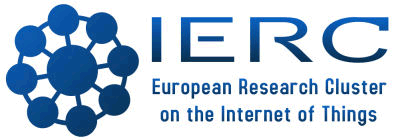Navigation
 Home
Home Contact Us
Contact Us Search the Site
Search the SiteThe ebbits Project
 Project Overview
Project Overview The Platform
The Platform Try our ebbits on-line demos
Try our ebbits on-line demos Partners
Partners List of deliverables
List of deliverablesNewsroom
 All News
All News Events
Events Conference publications
Conference publications Journal publications
Journal publications All project publications
All project publications ebbits in the press
ebbits in the press Video archive
Video archiveAffiliations
The ebbits project is affiliated with the following programs and organisations:
The ebbits project is active in the FInES cluster, the Future Internet Enterprise Systems (FInES) Cluster, where ebbits is leading the taskforces on international relations and manufacture and industry. Read more here.

The ebbits project is part of the Cluster of European projects on the Internet of Things. The Cluster aims to promote a common vision of the Internet of Things. ebbits is leading the taskforce on semantic interoperability
About us
The ebbits project is a 4-year project started in 2010. It is partly funded by the European Commission under the 7th Framework Programme in the area of Internet of Things and Enterprise environments under Grant Agreement no. 257852

 Impressum
Impressum  Privacy
Privacy

Newsletter Subscription
Registered Members Only
Previous newsletters
Read previous issues of our newsletter here: September 2011
September 2011 August 2012
August 2012 August 2013
August 2013
 June 2014
June 2014
 March 2015
March 2015Popular Downloads
 D5.1.1 Concept and Tec... D5.1.1 Concept and Tec... |
15000 |
 Anonymous Networking ... Anonymous Networking ... |
9992 |
 D3.8 Legal, IPR and li... D3.8 Legal, IPR and li... |
8968 |
 The EBBITS Project: An... The EBBITS Project: An... |
7488 |
 The Semantic Middlewar... The Semantic Middlewar... |
5414 |
Sign In
Downloads: IoTLink: An Internet of Things Prototyping Toolkit
Downloads Home > Conference and other scientific publications > IoTLink: An Internet of Things Prototyping Toolkit
 |
Downloads: 100 Downloaded: 197473 Most Downloaded: D5.1.1 Concept and Technologies in Intelligent Service Structures 1.pdf [ 15000 ] Most Recent: Brochure [ 2215 ] |




